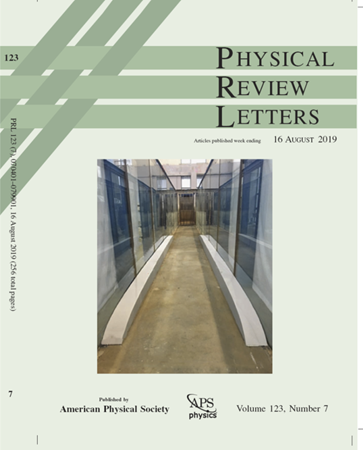多体相互作用下玻色子拓扑边缘模式的命运
IF 9
1区 物理与天体物理
Q1 PHYSICS, MULTIDISCIPLINARY
引用次数: 0
摘要
由于磁振子、三介子或其他准粒子带结构的非平凡拓扑结构,许多磁性材料在其激发光谱中预测会表现出玻色子拓扑边缘模式。然而,理论预测和实验观察之间存在差异,这表明某些潜在的机制内在地抑制了预期的实验特征,如热霍尔电流。在非相互作用的准粒子图中没有考虑到的多体相互作用通常被认为是拓扑边缘模式缺失的原因。在这里,我们报告了在完整的多体相互作用存在下,具有间隙三子激发的阶梯量子顺磁体边界处的持久玻色子边缘模式。我们使用张量网络方法来解析随时间变化的自旋-自旋相关和动态结构因子中的拓扑边缘模式,这在实验上是可以直接得到的。我们进一步证明,即使在非相互作用的准粒子理论失效时,这些边缘模式的特征仍然存在;我们讨论了该模型的拓扑相图,展示了其低洼激励的分数化,并提出了潜在的候选材料。本文章由计算机程序翻译,如有差异,请以英文原文为准。
Fate of Bosonic Topological Edge Modes in the Presence of Many-Body Interactions
Many magnetic materials are predicted to exhibit bosonic topological edge modes in their excitation spectra, because of the nontrivial topology of their magnon, triplon, or other quasiparticle band structures. However, there is a discrepancy between theory prediction and experimental observation, which suggests some underlying mechanism that intrinsically suppresses the expected experimental signatures, like the thermal Hall current. Many-body interactions that are not accounted for in the noninteracting quasiparticle picture are most often identified as the reason for the absence of the topological edge modes. Here we report persistent bosonic edge modes at the boundaries of a ladder quantum paramagnet with gapped triplon excitations in the presence of the full many-body interaction. We use tensor network methods to resolve topological edge modes in the time-dependent spin-spin correlations and the dynamical structure factor, which is directly accessible experimentally. We further show that signatures of these edge modes survive even when the noninteracting quasiparticle theory breaks down; we discuss the topological phase diagram of the model, demonstrate the fractionalization of its low-lying excitations, and propose potential material candidates.
求助全文
通过发布文献求助,成功后即可免费获取论文全文。
去求助
来源期刊

Physical review letters
物理-物理:综合
CiteScore
16.50
自引率
7.00%
发文量
2673
审稿时长
2.2 months
期刊介绍:
Physical review letters(PRL)covers the full range of applied, fundamental, and interdisciplinary physics research topics:
General physics, including statistical and quantum mechanics and quantum information
Gravitation, astrophysics, and cosmology
Elementary particles and fields
Nuclear physics
Atomic, molecular, and optical physics
Nonlinear dynamics, fluid dynamics, and classical optics
Plasma and beam physics
Condensed matter and materials physics
Polymers, soft matter, biological, climate and interdisciplinary physics, including networks
 求助内容:
求助内容: 应助结果提醒方式:
应助结果提醒方式:


